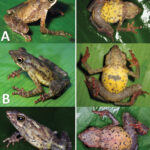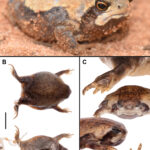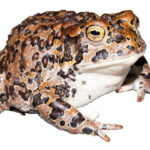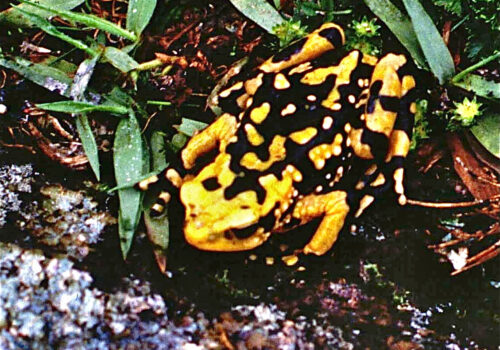Atelopus oxapampae: Rediscovering Peru’s Vibrant Jewel of the Forest#
In the lush, mist-covered forests of central Peru, a tiny, vibrant-colored frog hops unnoticed among moss-covered rocks and leafy ferns. This brilliant creature, known scientifically as Atelopus oxapampae, remains one of the most captivating, yet least understood inhabitants of these delicate ecosystems. Belonging to the famously threatened yet remarkably diverse family of harlequin frogs (Bufonidae), Atelopus oxapampae dazzles with its luminous skin and beckons the curious observer deeper into its hidden world.
Despite its enchanting appearance, the Oxapampa Harlequin Frog remains under significant threat, dangerously close to the brink of extinction. But recently, after years of elusive absence and presumed disappearance, this resilient amphibian has staged a surprising comeback. Thriving now in carefully preserved pockets of biodiversity, Atelopus oxapampae proves a symbol of both ecological fragility and hope for conservation efforts worldwide.
Taxonomy and Classification#
The Oxapampa Harlequin Frog, scientifically classified as Atelopus oxapampae, falls within the diverse amphibian family Bufonidae, commonly known as true toads. However, unlike the stereotypically rugged, dry-skinned toads familiar to many, this species—and the entire Atelopus genus—features vividly colorful, smooth-skinned frogs uniquely adapted to the humid forest conditions.
The genus name Atelopus groups together a remarkable set of amphibians known collectively as “harlequin frogs.” Their bright, intricate coloration patterns, varying from vibrant yellows and oranges to arresting greens and blacks, link the member species visually. Within this group, Atelopus oxapampae stands out distinctly, endemic to a restricted geographic area and possessing arrayed hues that blend wonderfully into the lush forest foliage.
First scientifically described as recently as 2008, this amphibian symbolizes not just biological diversity but also our ongoing discovery and understanding of our planet’s remarkable web of life.
Natural Habitat#
The story of Atelopus oxapampae is inseparable from its habitat in the cloud-drenched montane forests in the Oxapampa Province, located in the Pasco region of Peru. Towering with tall trees draped in orchids and dripping with moisture, these cloud forests exist at elevations typically ranging from 1,770 to 2,200 meters above sea level, creating a unique climate characterized by persistent mist, gentle rains, and cooler temperatures, ideal for amphibians.
Here, Atelopus oxapampae inhabits pristine streams and rippled cascades speckled across shaded rainforests. Its powerful legs and the renowned agility aid in navigating through rocks, roots, and leaf litter along fast-flowing streams. Such habitats, largely untouched and biologically rich, remain crucial for this frog’s lifecycle—from laying eggs in moist substrates to providing secure retreats from predators.
When walking quietly through the slightly eerie twilight of these montane trees, one may glimpse this brightly colored amphibian, its vibrant skin serving as both camouflage and warning sign. The thick vegetation stands guard over myriad species, many of which remain undiscovered, and the Oxapampa Harlequin Frog fittingly occupies this mysterious milieu as guardian and representative alike.
Physical Characteristics#
Beauty and intrigue converge notably upon the body of the Oxapampa Harlequin. Measuring just 21 to 29 millimeters in length, it may initially seem diminutive and unassuming—but appearances deceive. Up close, detailed observation unveils a true masterpiece of evolutionary artwork.
Displaying a mosaic of bright, streaking patterns, the frog’s skin ranges from vibrant lemon yellows to deep chocolate browns, accented frequently with cream-colored or black markings. These striking, contrasting colors perform double duty—as camouflage amid sunlit leaves and damp mosses, and as warnings that signal its potent chemical defenses to potential predators.
The frog’s physique is streamlined for motion, with slender yet muscular limbs designed for accurately leaping from slick stream-side surfaces. Its smaller, pointed digits effortlessly grasp rocks, leaves, and branches—exemplifying expertly evolved adaptations for survival in a moisture-laden and treacherously slippery environment.
Behavior and Life Cycle#
Feeding and Activity#
Despite its colorful visibility, the Oxapampa Harlequin Frog leads a relatively secretive life. Like other amphibians, it is primarily insectivorous, preying on a diverse assortment of small insects and arthropods that roam driven by humidity across shaded forest floors. Patient and watchful, the frog relies largely on stealth, speed, and precision. Its movements are finely calibrated—poised leaps peaking in quick lunges that capture unsuspecting prey with startling efficiency.
Being diurnal creatures, actively roaming during daylight hours amid streams and paths, they maximize sunlight’s warmth and energy, integral to their ectothermic lifestyle. The frog’s behavior as careful sunbathers contributes to their metabolic health, aiding digestion and immunity.
Reproduction and Parental Care#
Alongside the fluid symphony of trickling streams, the courtship rituals of Atelopus oxapampae unfold each rainy season. Males stake vocal territorial claims through soft, trilling calls barely audible above water murmurs and dripping foliage. Females carefully approach, captivated by these energetic performances signaling genetic strength and territory suitability.
Following successful mating, females lay gelatinous egg clusters delicately fixed beneath submerged rocks or leaf litter, sheltered from currents and predators alike. The tadpoles emerge shortly thereafter, equipped for a challenging aquatic phase, adapted if only briefly to underwater existence. Eventually, metamorphosis transforms these aquatic larvae into terrestrial juveniles, continuing the life story above water among lush forest pathways.
Ecological Role#
As small in stature as it seems, the Oxapampa Harlequin Frog holds significant stature ecologically. Primarily capturing insects, including flies, mosquitoes, spiders, and beetles, it acts as an effective and continual regulator against populations that might otherwise multiply unchecked.
Simultaneously, its defensive toxins deter predators from consuming it, teaching local predators caution and moderation in dietary choices. Yet, it still provides nourishment to certain predators especially adapted to manage amphibian toxicity, contributing to balancing the predator-prey dynamics essential for thriving, cohesive ecosystems.
Furthermore, due to this amphibian’s rapid sensitivity to environmental changes—including water pollution or climate fluctuations—it serves as an important indicator species, its population numbers alerting conservationists to critical ecological disturbances long before the effects become widespread.
Threats and Conservation Status#
Regrettably, despite this colorful guardian of biodiversity, severe threats overshadow its existence. Declines primarily induced through habitat destruction, pollution, climate change, and especially amphibian chytrid fungus (Batrachochytrium dendrobatidis) devastation have pushed this species to critical junctures.
At present, the International Union for Conservation of Nature (IUCN) classifies Atelopus oxapampae as Critically Endangered—a grave indication pointing to an immediate necessity for commitment to rigorous conservation measures. Conservation effort includes habitat protection, restoration projects, research into fungus treatment methodologies, and international partnerships committed to amphibian survival.
Cultural and Scientific Significance#
Atelopus oxapampae resonates strongly with local communities living close to nature, symbolizing interconnectedness and reverence for ecological balance. Though little documented in folklore, its colorful appearance and life story have nonetheless inspired awe and interest, symbolizing nature’s complexity and the urgent necessity for harmony.
Scientifically, the Oxapampa Harlequin Frog’s predicament highlights global biodiversity crises, symbolizing the urgent need to address climate challenges and protect forests. Its population’s recent rediscovery—a beacon of hope and resilience—promises valuable lessons in conservation biology and restoration success, reminding humanity about ecological interconnectedness across global ecosystems.
Conclusion: The Call to Conservation#
The vibrant, endangered Oxapampa Harlequin Frog personifies both nature’s beauty and fragility. Its recent rediscovery emphasizes hope even amid environmental peril. Championing its conservation requires collective responsibility, increased awareness, and collaborative global efforts to preserve the delicate tapestry of life surrounding this spectacular and significant amphibian.
Understanding, awareness, and timely conservation can ensure not only the survival of Atelopus oxapampae, but also countless other endangered species living inconspicuously alongside. Let its plight inspire action, restore resilience, and preserve earth’s remaining treasures.








